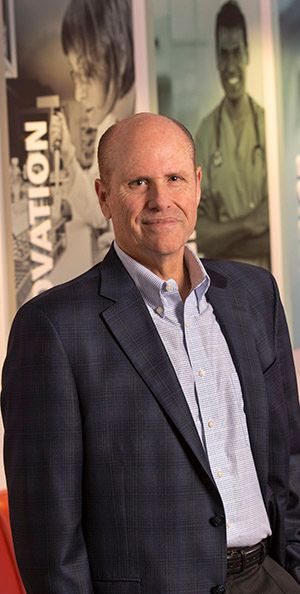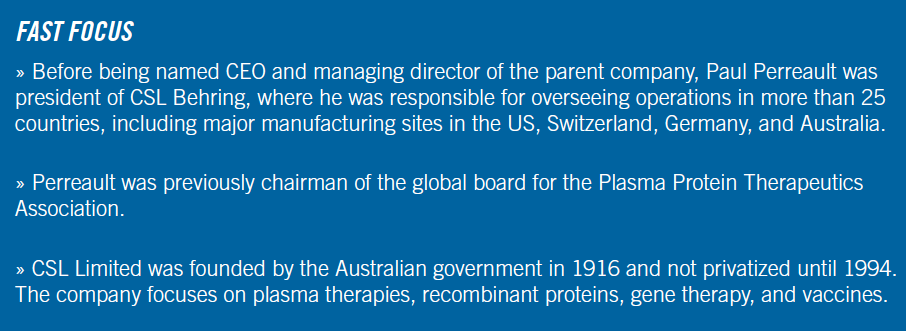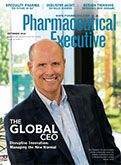- Sustainability
- DE&I
- Pandemic
- Finance
- Legal
- Technology
- Regulatory
- Global
- Pricing
- Strategy
- R&D/Clinical Trials
- Opinion
- Executive Roundtable
- Sales & Marketing
- Executive Profiles
- Leadership
- Market Access
- Patient Engagement
- Supply Chain
- Industry Trends
Paul Perreault: The Global CEO
Pharmaceutical Executive
Pharm Exec talks with CSL Limited’s top executive about the realities of running the global, Australian-headquartered specialty biotech company and sustaining a strong focus in a fast-encroaching era of disruptive technologies and new priorities in innovation and R&D.
Pharm Exec speaks with CSL Limited CEO and Managing Director Paul Perreault about the realities of running the global, Australian-headquartered specialty biotech-and the new normal for multinationals in navigating the fast-encroaching era of disruptive technologies and new priorities ininnovation and R&D
After graduating with a psychology degree from the University of Central Florida, Paul Perreault joined Wyeth-Ayerst Laboratories as a sales rep in 1981. At that time, he says, “I really thought I was going to retire as a sales rep. I didn’t think about ever being a CEO; I didn’t have this grand plan to climb the ladder.” But his subsequent
Paul Perreault, CEO and managing director, CSL Limited. (Photo /Tom Grimes)

career path saw Perreault gain experience in a wide range of industry roles, including training, management, marketing, operations, and finance; he took on additional responsibilities and challenges and pursued opportunities that came his way “even if it did not mean a promotion.”
After 16 years at Wyeth, Perreault joined Aventis Behring in 1997, where he held several executive positions before rising to executive vice president, worldwide commercial operations, with responsibility for all commercial and business development activities globally. The Australian-based CSL Limited acquired Aventis Behring in 2004; CSL Behring is now a global leader in the plasma protein biotherapeutics industry. Perreault became president of CSL Behring in 2011, and in 2013 was also appointed CEO and managing director of CSL Limited. Earlier this year, The Australian Financial Review named him 2017 CEO of the Year.
Pharm Exec sat down with Perreault to explore his leadership style and gauge the day-to-day realities of running a global specialty biotech company, as well as understand how he sustains a strong focus for CSL as new, disruptive technologies make their presence felt in the industry.
PE: You studied psychology as an undergraduate. It may be a cliché to say that must have been useful in dealing with people, but how did it feature in your move to industry?
PERREAULT: First of all, I needed to get a job. I graduated and I had bills to pay, so I started looking for one. I was familiar with the pharmaceutical industry a little and I was fortunate to get a position in sales with Wyeth. When people think of psychology, they think of putting somebody on the couch, or mind reading or something. But it’s really about the way people behave and understanding how organizations operate. So, it was natural for me to want to understand how people are motivated and how they have different desires and goals. And when you’re in sales, that’s very important because a doctor is not a doctor is not a doctor. They all come from different backgrounds, different schools. Like patients, they’re not all homogeneous.
I would say that psychology helps with understanding human behavior and how people operate. Not that I would analyze people. However, working in the pharmaceutical industry also meant that I had to gain a broader understanding of the industry I was in and hone skills outside of psychology. I undertook medical training and courses at University of Florida medical school on a self-study program, which covered pharmacology, biochemistry, anatomy, physiology, medical terminology, etc., and I completed advanced business management training at the Kellogg and Wharton schools of business.
PE: How does your current role and the culture of CSL continue to motivate you?
PERREAULT: The main motivation is the ability to impact the lives of patients that we serve. We produce treatments for rare and serious diseases, therapies that are important to patients, of which many may have gone undiagnosed for many years. I know hundreds of patients personally. That gets me going every day because I know that people are depending on CSL and the therapies we deliver.
I don’t do that alone, of course. The organization’s 22,000 employees have a big impact on what we do, and what I love about our culture is that people are engaged in that process. Obviously, you’ll hear the commercial people who engage with patient organizations talking about patients, but you’ll also hear people in finance, people in R&D talking about patients. It’s a culture that extends to our raw material supply, because a lot of our

products are made from human plasma and proteins. Special donors come in every week to donate plasma. We connect them with patients at the very beginning; each of our plasma centers runs an Adopt-a-Patient program. Engaging with patients permeates throughout the entire organization. In fact, we were patient-focused before it was trendy. That’s the culture that’s maintained here, and it has to start with me. I can’t just sit here and tell a department that they should be patient-focused.
CSL was started over 100 years ago by the Australian government as a not-for-profit agency committed to bringing essential medicines to the people of Australia during World War I when the supply chains from Europe were cut off. That patient focus, which was the core and foundation of the company at its inception, still hasn’t changed.
When CSL privatized from the Australian government and went public in 1994, it was a small company and it took an intense amount of focus to begin the process of globalization. But we leveraged our core competencies, our core adjacencies and synergies to grow the organization. It was about organic growth and doing those things in which we have knowledge and capabilities exceptionally well. We don’t engage with M&A just for the sake of M&A. We continue to reinvest in the company-because I haven’t found a whole lot better to reinvest in. We have done a couple of acquisitions and some licensing deals, but they are all in our area of focus. I think that’s what differentiates us. We don’t say we’re going to build an area in oncology, for instance, just because 50% of R&D spend these days is in oncology. That doesn’t mean it’s the right place for CSL. You have to have discipline and focus.
PE: How do you maintain that strong focus going forward?
PERREAULT: We focus on the capabilities or the competencies we have. For instance, we just moved into transplantation. But we have current marketed products that have application in transplantation. We understand the products deeply, we understand the mechanisms of action, and we can see the applicability in this new area. Transplant is also an area where you don’t need a primary care sales force of 2,000 or 3,000. We can do this within our organization. We already have the resources and the assets, we have the knowledge of the therapies, and we can see how it’s applicable to what we do.
Bio highlights; click to enlarge

We have at least three products that we think are applicable in transplant and can really change the treatment landscape for these patients. So, when people see us moving into a new area, it’s because we already have expertise in that area, in the development and manufacturing, in the product profile, or in our ability to really add value. We’ve seen other pharma companies go out and spend a lot of money buying another company. They grow it for a year or two, then they have to grow on top of that. Later you see them divest, saying “It’s no longer core,” which sometimes means, “We couldn’t make it work.” It disrupts the organization; it doesn’t add value over the long term. It’s really a matter of maintaining that focus.
PE: What is the significance of CSL’s Australian origins and activities on the way you go about your business now?
PERREAULT: When CSL privatized from the government, there were a few things that the government required at that time. One was that the chair of the board needs to be an Australian citizen. Also, two-thirds of board members need to be Australian citizens, and the company has to remain listed in Australia. Because of our expertise and our size, we’re now the fourth-largest company on the Australian stock exchange by market cap.
Australia is a key part of what we do, but it’s also a market like the other markets we serve. We have manufacturing in Australia, which is part of our global supply chain along with other plants in China, Germany, Switzerland, UK, and the US. The way we operate is to make sure that those plants are integrated across the processes and across the product portfolios as much as possible. Australia is a key piece of that.
Australia is also our center of excellence for research and development. Our R&D group operates as a global function, but research in Australia is really the hub. We have hundreds of scientists in Australia doing our initial research and then they work with teams across our other research sites in Germany, Switzerland, and the US. It’s kind of a hub-and-spoke model. We have over 30 university collaborations in Australia. If we were in Boston or San Francisco, we’d be competing with many others. But in Australia, we get to have a good look at a lot of the top science that comes around and that’s why our research is still based there. What comes out of our research labs in Australia has a big impact on what we do for our future innovation.
PE: What would you say are the critical skills for your role, and how have these changed over the course of your career?
PERREAULT: The first is to focus on your strength and synergies and don’t get distracted. That can be difficult because you get bombarded with so much stuff these days. Everything is global, everything’s immediate, everybody’s chasing the next shiny object. That focus is critical and leadership really needs to maintain that.
The second thing is collaboration. As a company, we have to act both locally and globally because we are engaging with global patient communities. Our partnerships with patients and advocacy organizations reach across the globe, so collaborating with and promoting early diagnosis and treatment of the conditions and the diseases are critical.
The third strength is communication. A lot of companies tend to act more internationally, I would say. They focus on the US and Europe and then everything else. We actually work globally. Whenever we do something in one country, we aim to understand how it impacts everywhere else. So, someone is on the bad end of a phone call every night. It’s one thing to be dealing between the US East Coast and Europe, or Europe and Australia, or Australia and China; but if you’re dealing with Australia, Asia, Europe, and the US, somebody’s going to be up late or up early. That’s a skillset that some organizations struggle with.
We do advise people that if you work here and you’re on a global team, it’s going to take some stamina. Everybody knows the direction of the company and the culture and the expectations. You have to know your priorities and how they align with the core adjacencies and competencies. Then you have to execute. Execution is critical. At CSL, we work every day like somebody’s life depends on it, because it does.
The way things have changed is the focus you have to have from an innovation and an R&D perspective. I can remember the 1980s and 1990s; they were very good days in the pharma business. But there were a lot of “me-too” products coming out. In today’s market, if you try to do that, you’re not going to get reimbursement. You’re not going to get access, patients won’t get access because governments won’t pay. You have to beef up your skills in terms of pharmacoeconomics. You have to look at how the clinical trials are actually organized so that you get the data that you need from a pharmacoeconomic perspective that shows the benefit to the patients and to the healthcare system over time. That’s something that we really have to focus on as an industry to make sure that we are making a real difference and that innovation wins the day. If you’re not innovating, get out of the business, because you won’t be here for the long term.
PE: Looking to the future, how does your vision for CSL fit into where the industry is heading?
PERREAULT: I’m focused right now on 2030, and there’s a few things that give me confidence that we’re in pretty good shape. There are not many companies that have products like ours, which are basically donated from a human and go back into a human. We serve patients now in over 60 countries, and that translates to a lot of people with rare diseases, for instance, hemophilia. We are getting closer to gene therapy for hemophilia, but currently 75% of the world’s hemophilia population is either undertreated or not treated. There are still a lot of

patients to serve around the globe. There is a strong demand, especially for our largest portfolio of products in the immunoglobulin space. But I don’t have my head in the sand, thinking that this is going to go on forever.
Our organic growth will come from sustaining our ability to invest in new therapies. We’re looking at disruption, we’re looking at new technologies. Last year, for example, we bought California’s Calimmune, which is developing an ex vivohematopoietic stem cell (HSC) gene therapy, CAL-H, for the treatment of sickle cell disease and beta thalassemia. While the first area is sickle cell, it’s a platform with potential for treatments for a wide range of other rare diseases that complement CSL’s business. So instead of chasing down every new and, as I said, shiny object that comes out of, say, CRISPR technology, or choosing a new gene therapy, this is more of a platform approach, which gives us optionality.
PE: Does it get easier or harder to look so far ahead?
PERREAULT: I think it’s going to get harder because of the technologies around the delivery of medicines, and the transformation of cells and genes. In 2030, for example, will you still be able to be a researcher, developer, a manufacturer, and seller of pharmaceuticals, or is that chain going to be disrupted somewhere? Is the black box where all this magic happens going to be owned by a GE, for instance, who take the majority of the value in the chain?
In some ways, this industry hasn’t progressed as much as I’d like to see. We’re not innovating in supply chain operations as much as the consumer sector has already done. I don’t necessarily want to be the first cab off the ranks, as we say, but I also don’t want to be the last cab off the ranks. I want to be near the front edge of thinking about these things, whether it’s AI, whether it’s blockchain, you name it. These are things that are happening and we need to pay attention.
PE: As you mentioned, being a leader at CSL takes stamina. How do your outside interests help keep you focused?
PERREAULT: I love the outdoors. I love the fresh air, being in nature, hiking, skiing. Those are the things I like to do. You fit these things in as often as you can, but these roles, at least from my experience, are pretty all-consuming. I don’t want my job to become who I am, though, because it can all go away in a heartbeat. I try to get to the gym every day. I was at the gym this morning for 45 minutes just to get the blood pumping and get things going, because if you don’t, it can be pretty draining. I guess I’m fortunate that I’m used to it and I don’t need as much sleep as some other people.
I walk the halls, I do a lot of managing by walking around. I was on the road for more than 200 days last year. People in our company know me. And that’s because I feel I need to be inthe business. I need to understand and see what’s happening. I can’t just sit in the office and think I know everything. You have to be authentic-in leadership, authenticity is vital.
Julian Upton is Pharm Exec’s European and Online Editor. He can be reached at julian.upton@ubm.com

